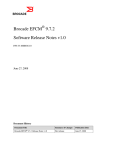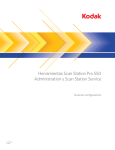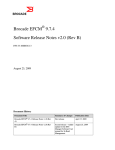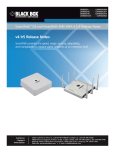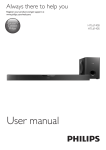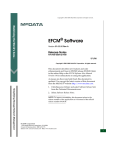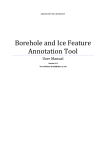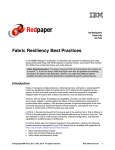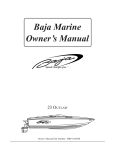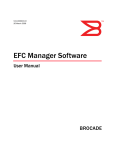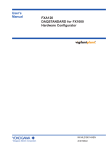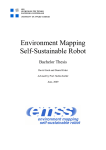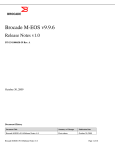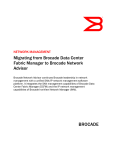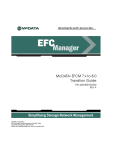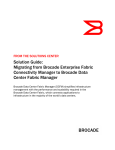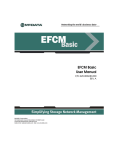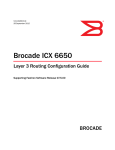Download Brocade EFCM 9.7.3 Software Release Notes v3.0 (rev C)
Transcript
® Brocade EFCM 9.7.3 Software Release Notes v3.0 (rev C) P/N 53-1000636-12 November 21, 2008 Document History Document Title ® Brocade EFCM 9.7.3 Release Notes v3.0 (rev C) Summary of Changes Publication Date First release November 21, 2008 Copyright © 2006-2008 Brocade Communications Systems, Inc. All Rights Reserved. Brocade, Fabric OS, File Lifecycle Manager, MyView, and StorageX are registered trademarks and the Brocade Bwing symbol, DCX, and SAN Health are trademarks of Brocade Communications Systems, Inc., in the United States and/or in other countries. All other brands, products, or service names are or may be trademarks or service marks of, and are used to identify, products or services of their respective owners. Notice: This document is for informational purposes only and does not set forth any warranty, expressed or implied, concerning any equipment, equipment feature, or service offered or to be offered by Brocade. Brocade reserves the right to make changes to this document at any time, without notice, and assumes no responsibility for its use. This informational document describes features that may not be currently available. Contact a Brocade sales office for information on feature and product availability. Export of technical data contained in this document may require an export license from the United States government. The authors and Brocade Communications Systems, Inc. shall have no liability or responsibility to any person or entity with respect to any loss, cost, liability, or damages arising from the information contained in this book or the computer programs that accompany it. The product described by this document may contain “open source” software covered by the GNU General Public License or other open source license agreements. To find-out which source software is included in Brocade products, view the licensing terms applicable to the open source software. And obtain a copy of the programming source code. Please visit http://www.brocade.com/support/oscd. EFCM® Software Version 09.07.03 Page 2 of 26 Contents Overview .......................................................................................................................................................................4 What’s New in EFCM Version 9.7................................................................................................................................5 New Hardware Support .............................................................................................................................................5 New Features .............................................................................................................................................................5 Upgrade/Downgrade Considerations.............................................................................................................................5 Operating Systems Supported........................................................................................................................................5 Server / Client............................................................................................................................................................6 Product Operating Notes ...............................................................................................................................................7 Flavors .......................................................................................................................................................................7 Compatibility .............................................................................................................................................................7 Configuring the Number of Event Limits..................................................................................................................8 Disabling the SNMP Proxy .......................................................................................................................................9 Managing Blade Switch Considerations....................................................................................................................9 Important Notes ...........................................................................................................................................................10 Zoning Related Change for FOS-based Fabrics ......................................................................................................10 Issue.....................................................................................................................................................................10 Solution................................................................................................................................................................10 Fabric Binding .........................................................................................................................................................11 Fabric Binding In B model Routing Environments .............................................................................................13 Advanced Call Home...........................................................................................................................................14 No Disk Error upon Launching Local Client.......................................................................................................14 Related Documentation ...............................................................................................................................................19 Opening the Online Help .........................................................................................................................................19 Opening the User Manuals ......................................................................................................................................19 Documentation Updates ..............................................................................................................................................20 EFCM User Manual (Publication Number 53-1000663-03) ...................................................................................20 Fixes / Code Enhancements in EFCM 9.7.3 ................................................................................................................20 Open Issues in EFCM 9.7.3.........................................................................................................................................21 Reported Issues to be fixed in EFCM 9.7.3 .................................................................................................................26 EFCM® Software Version 09.07.03 Page 3 of 26 Overview Brocade Communications Systems, Inc. is pleased to deliver the EFCM® 9.7.3 release. • A list of the defects that were closed in EFCM® 9.7.3 has been added to the end of these release notes. Fixes in EFCM 9.7.3 Refer to the EFCM 9.7 software manual set and online help for instructions on using this application. As issues are discovered and fixed, this document is updated. The most recent version of documentation is provided on the Brocade Web site, through Brocade Connect. Go to http://www.brocade.com and click Brocade Connect to register at no cost for a user ID and password. Note: To improve readability, this document refers to the release number of the application as 9.7.3 instead of the official release number 09.07.03. Note: For your convenience, we have retained the legacy McDATA names to avoid any confusion. Please refer to the following table for the equivalent Brocade names for legacy McDATA products. Brocade Names Legacy McDATA Names Brocade EFCM EFCM Brocade M-EOSc E/OSc Brocade M-EOSn E/OSn Brocade M6140 Director Intrepid 6140 (ED-6140) Brocade M4700F Switch Sphereon 4700 Brocade Mi10k Director Intrepid 10000 Director (i10k) EFCM® Software Version 09.07.03 Page 4 of 26 What’s New in EFCM Version 9.7 The focus of the EFCM 9.7 release is to cover the 8Gb switches that will be available as part of the Mariner release. This includes Native Interoperability support for these platforms as well into M/EOS environments. Support for 8Gb HBAs is also included with this release. Other specific enhancements are outlined in detail below. New Hardware Support 8Gb switches: • Brocade 5300 • Brocade 5100 • Brocade 300 8Gb HBAs • Brocade 415 • Brocade 425 • Brocade 815 • Brocade 825 New Features • Native Interoperability support for the 8Gb switches • Access Gateway support for the Brocade 300 switch • Cascaded FICON support between Mi10K/M6140 and Brocade 48K/Brocade DCX: configuration of and management of cascaded FICON will be accomplished via a combination of EFCM and the FOS element managers (Web Tools) • IPv6 support for the Mi10K and M6140 from the EFCM client to the server to the switch • Fabric Binding support for Open Fabric mode (InterOp Mode 3). o Note: Please refer important notes section for Fabric Binding support in B model Routing Environments Upgrade/Downgrade Considerations • If you have EFCM 8.7 or later, you can perform a direct migration to EFCM 9.7.3 without a stop-over at EFCM 9.1. • If you have SANavigator 4.2 and 4.2.1, first upgrade to EFCM 9.5 or 9.6 and then to EFCM 9.7.3 • Upgrade your EFCM/CM to EFCM 9.7/CM 9.7 before upgrading the Mi10k director to M- EOSn 9.7 or later • If you have HAFM 8.8 or later, first upgrade to EFCM 9.5 or 9.6 and then to EFCM 9.7.3 For detailed upgrade instructions, refer to the EFCM Software Upgrade Instructions provided in the EFCM 9.7 documentation CD-ROM. Operating Systems Supported EFCM 9.7.3 is supported on the following operating systems. EFCM® Software Version 09.07.03 Page 5 of 26 Server / Client Operating System Versions Windows XP Professional SP2 2003 Server SP2 2000 Professional SP41 Solaris 9, 10 Linux Red Hat 9.0, kernel 2.4.20, Red Hat ES version 3, kernel 2.4.21 Red Hat ES version 4, kernel 2.6.9-5 SuSe Linux Professional Edition 9.2, kernel 2.6.x SuSe Linux Professional Edition 9.3, kernel 2.6.x 1 No support for IPv6 on Windows 2000. EFCM® Software Version 09.07.03 Page 6 of 26 Product Operating Notes Flavors The flavors supported in the EFCM 9.7.3 release are: • Connectrix Manager • EFCM Compatibility The following table describes the firmware that EFCM 9.7.3 supports for both B model and M model switches and directors. Operating System Switch/Director Switch Type (B-Model) Firmware Versions FOS 5.2.x, 5.3.x, 6.0.x, 6.1.0 and 6.1.1 Brocade 7500 Brocade 200E Brocade 5000 Brocade 4900 Brocade 48000 with FC4-16, FC4-32 and FC4-48 blades Brocade 48000 with FC8-162, FC8-323 and FC8-483 blades Brocade DCX with FC8-162, FC8-322 and FC8-48 blades2 Brocade DCX with FR4-18i blades2 Brocade DCX with FC10-6 blades2 Brocade 3003 Brocade 51003 Brocade 53003 ____________________________ EFCM® Software Version 09.07.03 Page 7 of 26 Blade Type (B-Model) Firmware Versions FOS 5.2.x, 5.3.x, 6.0.x, 6.1.0 and 6.1.1 Brocade 3014 Brocade 3016 Brocade 4020 Brocade 4016 Brocade 4024 Brocade 4018 Brocade 4012 Brocade 54103 Switch Type (M-Model) Firmware Versions M-EOSc 9.1, 9.2, 9.6, 9.6.1, 9.6.2, 9.7, 9.7.1, 9.7.2 and 9.8 Brocade M6064 and M6140 Brocade M4300, M4400, M4500 and M4700 Brocade M3016, M3032, M3216 and M3232 E/OSi 4.7 and 5.0 Brocade M1620 and M2640 M-EOSn 6.x, 9.1, 9.2, 9.6, 9.6.1, 9.6.2, 9.7, 9.7.1, 9.7.2, 9.8 and 9.8.1 Brocade Mi10K M-EOSc 9.0, 9.1, 9.2, 9.6, 9.6.2, 9.7, 9.7.1 9.7.2 and 9.8 QPM (Quad Port Module) card for Brocade M6064 and M6140 M-EOSn 9.1, 9.2, 9.6, 9.6.1, 9.6.2, 9.7, 9.7.1 9.7.2, 9.8 and 9.8.1 E/OSq 5.2.2, 5.2.3, 5.5.1, 5.5.2 and 6.4.0. and LMQ 4G line module for the Brocade Mi10K director M model blade switch Configuring the Number of Event Limits Perform the following steps to control how many event entries are read in from the event logs on the server, when the Client Monitor->Logs dialogs are used to review specific log categories, such as Audit logs. By default, only the last 2000 entries are scanned (default smp.logs.limit value) for events matching the dialog category (e.g. Audit) to display. 1. On the EFCM client navigate to the following directory location: <EFCM Installation Home>\resources\Client. 2. Open the config.properties file in a text editor. For example, use a text editor like Microsoft Window's Notepad. EFCM® Software Version 09.07.03 Page 8 of 26 3. Modify the smp.logs.limit parameter to the desired value. The values should be an integer in the range, 2000 to 20000. Any value other than this range or non-integer values like alphanumeric characters would result in the EFCM client failing to start. 4. After specifying valid values for this parameter, start the EFCM client application. Note a: Whenever you change the value of this parameter, you need to restart the EFCM client for the latest value to take effect. Note b: The Monitor Logs dialogs will still display a maximum of 1000 entries that match the item category. This display limit is not configurable. Note c: The smp.logs.limit parameter does not alter the behavior of the Master Log display, which is limited by design to displaying entries from the most recent 2000 logged events on the EFCM server. This limit is not configurable. Use the Monitor Logs dialogs to review older entries or review the Event log files on the EFCM Server host directly. Disabling the SNMP Proxy SNMP Proxy is enabled by default on all M model Blade switches. To ensure proper function of EFCM, disable the SNMP Proxy feature before attempting to discover the M model Blade switch in EFCM. Perform the following steps to disable the SNMP Proxy: 1. Telnet to the switch. 2. Login to the switch. 3. Type admin start and press ENTER. 4. Type set setup snmp and press ENTER. 5. Set the ProxyEnable setting to False. 6. At Do you want to save and activate the snmp setup? (y/n): [n] type y (yes). Managing Blade Switch Considerations If an error message, “received error in attempt to release admin privileges - reason: no response” is received while configuring the secure socket shell (SSH) service for switch blades using Element Manager, you must install the M model Element Manager feature. Do not use the Element Manager fabric binding feature on blade switches. Element Manager fabric binding does not synchronize with EFCM fabric binding. Therefore, if you use both the Element Manager and EFCM fabric binding features you can create a disconnect between the two features and this may result in any of the following: • If you activate an ISL set when a port set is already active, the ISL set takes over and vise-versa (working as designed). • If you activate switch binding within Element Manager and then activate fabric binding within EFCM, the fabric binding is stored by the blade and appended to the current switch binding security policy (working as designed). • However, after carrying out the above procedure, if you deactivate fabric binding within EFCM it only deactivates on the M model switches. To deactivate the policy on the Element Manager, you must open the Element Manager and deactivate the policy there. EFCM® Software Version 09.07.03 Page 9 of 26 • Note that switch binding is deactivated when the learned fabric policy is merged. To activate switch binding, you must activate the policy you created within the Element Manager again manually. Failure to perform this task can lead to a security lapse. • If switch binding is not activated within an Element Manager and fabric binding is activated within EFCM, deactivate fabric binding on the switch using EFCM (working as designed). • If switch binding is activated through an Element Manager and there is a F_Port logged into the blade that is not in the switch binding membership list (for example, an administrator command has not logged out the unwanted port), then fabric binding cannot be activated using EFCM. Important Notes Traffic Isolation and Frame Redirect Zone: Customers must upgrade to EFCM 9.7.3 if the fabric Contains Traffic Isolation (TI) or Frame Redirect (RD) zones. EFCM 9.7.3 will not support creating/deleting or updating Traffic Isolation or Frame Redirect zones. However if the fabric has Traffic Isolation or Frame Redirect zones, EFCM will not modify or clear them upon activation of other zone sets EFCM will fail to collect zone information if the B-model switch prompts to change its default password. Zoning dialog will fail to show active zones in the active zone set tab and the activate button will be disabled when the switch prompts to change its default password. To overcome this condition, user needs to configure the new passwords via web tools / telnet. Zoning Related Change for FOS-based Fabrics Issue Previous versions of EFCM prefix the zoneset name and zone name with "SMP_" upon activation of a zoning configuration for Brocade FOS-based fabrics. This was designed to prevent the deletion of zones and zone sets created and activated outside of EFCM. Retaining this design will introduce issues with LSAN and any other zoning prefixes used by FOS to do specific tasks. Solution Customers upgrading from versions prior to EFCM 9.6 to EFCM 9.7.3 will see the "SMP_" prefix in the Zoning dialog box for Brocade FOS-based fabrics. EFCM Brocade Plug will not prefix the zone set/zone name when it does the zone set activation on B model switches. Hence, when zone set activation is done through EFCM on B model switches, it will not prefix with "SMP_" for the zone set/zone name. The following options can be used to resolve this issue, but are only applicable to Brocade FOS-based fabrics that were zoned using a previous version of EFCM. Option 1: Use Export/ Import 1. Install EFCM 9.7.3 and migrate. 2. Save the active zone set of the Brocade FOS-based fabric into the Zoning Library. 3. Export the active zone set. EFCM® Software Version 09.07.03 Page 10 of 26 4. Edit the exported xml file and remove the "SMP_" prefix from all zones and zone sets. 5. Save the zone set xml file. 6. Import the xml file. The library should not show the zones or zonesets with the "SMP_" prefix. 7. Activate the imported zone set. 8. Using CLI, verify that the active zone set does not contain any zones or zone sets having the "SMP_" prefix. Option 2: Copy Active Zone Set into Library and Migrate 1. Before migrating to EFCM 9.7.3 : • Save the active zone set of the Brocade FOS-based fabric into the Zoning Library. • Shut down the EFCM Server. 2. Install EFCM 9.7.3 and migrate. 3. Start Server and Client. 4. Now the Zoning dialog box will show all active zones from the Brocade FOS-based fabric with "SMP_" prefix. But the already saved zone set at the Step 1.1 will not be shown with "SMP_" prefix. 5. Activate the zone set, which is already saved in Step 1.1. 6. Using CLI, verify that the active zone set does not contain any zones or zone sets with the "SMP_" prefix. For more details on this issue, refer to PR 88462. Fabric Binding In environments that are only enabling Fabric Binding on pure EOS-based fabrics, the below cautions does not apply. This is to highlight what users need to be aware of when enabling/disabling Fabric Binding in either a mixed EOS/FOS (InterOp) fabric, or pure FOS-based fabrics. NOTE: Fabric Binding feature is supported in B model fabrics which are running in InterOp Mode 3/Open Fabric Mode from FOS 6.1 version. Enabling Fabric Binding may cause disruption to a fabric either when enabling and/or disabling the feature. Since the Fabric Binding feature does not set the InterOp mode, it is recommended that you first build the fabric then enable the Fabric Binding feature. This is to ensure you resolve fabric conflicts first before trying to enable this feature. Some examples of conflicts could be; InterOp mode, Domain ID overlap, Time-Out values, etc. The table below outlines the Fabric-Wide Consistency Policy (FWCP) that is set, when enabling fabric binding. Each row represents a fabric with a specific InterOp mode setting. Fabric Binding Membership List to be Activated InterOp mode that the fabric is currently set to FWCP setting B model only WWNs Brocade Native Strict B model only WWNs McData Fabric Mode Strict B model only WWNs McData Open Mode Strict EFCM® Software Version 09.07.03 Page 11 of 26 InterOp mode that the fabric is currently set to FWCP setting Modifying an existing membership list of only B model WWNs to add one or more M model WWNs Brocade Native Tolerant Modifying an existing membership list of only B model WWNs to add one or more M model WWNs McData Fabric Mode Tolerant Modifying an existing membership list of only B model WWNs to add one or more M model WWNs McData Open Mode Tolerant B model and M model WWNs Brocade Native Tolerant B model and M model WWNs McData Fabric Mode Tolerant B model and M model WWNs McData Open Mode Tolerant Modifying an existing membership list of both B model and M model WWNs to remove all M model WWNs Brocade Native Strict Modifying an existing membership list of both B model and M model WWNs to remove all M model WWNs McData Fabric Mode Strict Modifying an existing membership list of both B model and M model WWNs to remove all M model WWNs McData Open Mode Strict B model and other WWNs that do not fall within the B/M model WWN ranges Brocade Native Tolerant B model and other WWNs that do not fall within the B/M model WWN ranges McData Fabric Mode Tolerant B model and other WWNs that do not fall within the B/M model WWN ranges McData Open Mode Tolerant Fabric Binding Membership List to be Activated Issue Cannot enable/disable Fabric Binding when a transaction is already in progress through Web tool/CLI. Solution EFCM will display an error message “Fabric binding failed because another transaction is in progress”. It is recommended that the user uses only the EFCM application to create/modify the Fabric Binding (SCC Policy on FOS-based switches) policy as using the CLI/EFCM Basic/Web tools may cause the EFCM application to get out-of-sync when opening the Fabric Binding dialog box. For more details on this issue, refer to PRs 89610 and 89585. EFCM® Software Version 09.07.03 Page 12 of 26 Issue Insistent DID not enabled for pure B model fabric. Solution In case of mixed fabrics (fabric connected with M model and B model switches), when fabric binding is enabled from EFCM, the Insistent Domain ID (IDID) setting on B model switches will be turned on. For pure B model EFCM will not enable Insistent Domain ID. As a result user will not be able to merge pure B model in IM2/IM3 with other fabrics. User will have to use web tools for enabling Insistent Domain ID for Pure B model fabrics and then merge the fabrics. For more details on this issue, refer to PRs 91392, 89785 and 89864. Issue Issue In Unique nickname mode user will not be able to set the same nickname for routed devices. Solution User will have to change the nickname settings from unique to non unique mode. For more details on this issue, refer to PR 93243 Fabric Binding In B model Routing Environments Fabric Binding support in the routing environments might fail in few cases. Please see the issues below to check if your fabric setup falls in any of the cases and ensure that fabric binding is supported for your fabric setup. Fabric Binding in Pure B model Edge fabric is supported for InterOp Mode 0(Brocade Native mode). InterOp Mode 2(McData Mode) and InterOp Mode 3(McData Open mode) are not supported. Issue FWCP is not set to tolerant when Front domain/Translate domain is added as detached WWN. Solution When user merges a pure B model fabric to pure B model edge fabric with fabric binding enabled separately, the merge fails because of FWCP mismatch. User needs to manually set FWCP to tolerant via Element Manager or CLI in the pure B model fabric which needs to be merged to the Edge fabric. For more details on this issue, refer to PR 91465. Issue Fabric Binding fails in Mixed Edge Fabric in IM3 when user doesn’t configure the preferred front port domain ID. Solution The preferred front port domain must be configured for fabric binding to work. The default value will not work. User needs to issue the portcfgexport command on FOS and use the –d option to explicitly set a domain id. The domain id configured on the EX_Port must be in the range 97-127. For more details on this issue, refer to PRs 91343 and 91415. EFCM® Software Version 09.07.03 Page 13 of 26 Brocade 4G / 8G HBA: EFCM discovery will identify the Brocade HBA 4G / 8G HBA and accordingly show the corresponding launch point (ESCM or the HCM Brocade FC HBA tool). If the HBA is a Brocade 4G HBA (Brocade 410 / 420 model PCIe FC HBA), the right-click menu will contain a menu to launch the ESCM tool. If the HBA is a Brocade 4G or 8G HBA (Brocade 415 / 425 / 815 / 825 model PCIe FC HBA): a. If the OUI in the WWN is not 00051E, then it will be shown as an HBA in the topology and the rightclick menu will have an option to launch the HCM tool. b. If the OUI in the WWN is 00051E, the HBA will be shown as a NPIV device in the topology and the right-click menu will contain HCM tool. Advanced Call Home Issue When a B model switch is assigned to an ACH Call Center, a CallHome event will be triggered if a firmware download/reboot operation is performed on a B model switch that is currently in a "Marginal/Down" health switch status. Solution The firmware download/reboot operation that is performed on B model switches will trigger a Call Home when the switch was previously in a non-healthy state; for example "Marginal" or "Down". The call home can be avoided by bringing the switch to a healthy state before doing f/w upgrade or manual reboot of the switch. For more details on this issue, refer to PR 92470. No Disk Error upon Launching Local Client Issue After installing EFCM 9.7.3, an error message "Windows - No Disk" may be displayed when the local EFCM Client is launched. Solution Reboot the host machine running EFCM 9.7.3 Client. For more details on this issue, refer to PR 31648. Multi-homed Environment Issue SNMP Trap registration may have the wrong IP set during initial discovery of B-Model, thereby no messages will be displayed in the master log and Call Home will fail. Firmware download and SupportSave using built-in FTP will also fail. NOTE: After discovering a B model switch, please verify that the IP address registered in SNMP configuration is reachable from Client and Server with the help of Element Manager (Webtools) or CLI. Solution EFCM® Software Version 09.07.03 Page 14 of 26 From Webtools or Element Manager edit the IP address of the switch's SNMP Trap Recipient configuration to an address which is reachable from client and server. The user needs to add/modify the parameter ‘FtpServer.server.config.host=<server IP>’, in the ftpd.conf file located on the EFCM server at: <Installed home>\ftpServer\apps\ftp\conf Example: FtpServer.server.config.host=172.32.5.24 The same server IP needs to be mentioned in the config.properties file present at <Installed_Home>\resources\Server. Example: smp.switchToServerIPAddress= 172.32.5.24 You must restart the EFCM server and the bundled FTP server. For more details on this issue, refer to PR 91366, 91843 and 92084. FICON RNID The following information on Request Node Identification Data (RNID) is not directly available through EFCM application for FOS devices at this time: • Serial # • Class • Tag • Protocol RNID information for FOS devices can be seen using FOS Element Manager (WebTools) for switches running FOS 6.1.0 and higher. Firmware Download for B-model Switches after migration in a Dual Homed environment Issue Solution Firmware download fails after migration from 9.6.x/9.7.x for FOS based switches from GCM in a dual NIC environment FTP services get started before the configuration files are migrated. Hence restart the FTP service after the migration For more details on this issue, refer to PR 92869. Known issues Issue Unable to perform any operations through "Telnet through server" on EOS-based switches. This problem is highly intermittent. Solution Right-click the switch and select the Telnet option. For more details on this issue, refer to PR 88916. Issue EFCM® Software Version 09.07.03 Page 15 of 26 When EFCM application is shutdown with the "Shutdown client" option checked, the EFCM client window is not closed and all open Element Managers grey out. Solution Close all open Element Managers and then shutdown the server and client. For more details on this issue, refer to PR 88163. Issue When EFCM Server has IPv4 and IPv6 protocols installed and the server is manually forced to bind to the IPv6 address, ECC API will not connect to this EFCM Server. This issue affects the Fibre Zone Bridge Agent, Brocade SWAPI Bridge Agent, MOM Discovery, and SMI-S for M-EOS provider (in proxy mode). Solution Use the default setting of Automatic in SAN > Options > IP Configuration > Server IP Configuration to have EFCM Server bind to all interfaces. Or, change the setting to 'Manual to bind to an IPv4 address.’ For more details on this issue, refer to PR 89210. Issue SNMP Trap stating "Login information via Telnet/HTTP from EFCM server IP" is shown in the Master Log. When fabric containing B model switches (Brocade native mode) are discovered, logs will be posted every polling cycle as telnet to switch is done to collect the Zoning information. Solution In the advanced filter, set an option to filter these logs. For more details on this issue, refer to PR 88942. Issue Support Save and Firmware Download do not work with Solaris and Linux when the internal FTP Server is running. Solution Enter the IP address of the EFCM server in /etc/hosts file. For more details on this issue, refer to PR 89215. Issue: EFCM fails to manage an i10K after upgrading the firmware with custom community string set in the snmp agent Solution: Reset the community string to default in both i10K and EFCM address properties before migrating the firmware and after migration, do a snmp reset and then give the appropriate community string both in i10K and EFCM For more details on this issue, please refer to PR 92878 Issue: EFCM® Software Version 09.07.03 Page 16 of 26 External FTP option creates a folder on FTP location if delete permissions are not given to the FTP user account Solution: EFCM creates a folder in FTP location when the user account used for external FTP is not given delete permissions. User can manually delete the created folder with user account which has delete permission. For more details on this issue, please refer toPR 92981 Documentation Corrections M6140 Fabric Switch Element Manager User Manual (53-1000668-03) Configuring SNMP Operating Parameters – Page 50: Add a note stating “Clearing all the community string entries will make the switch undiscoverable by EFCM” M6140 Director Element Manager User Manual (53-1000661-03) Configuring SNMP Operating Parameters – Page 56: Add a note stating “Clearing all the community string entries will make the switch undiscoverable by EFCM” Mi10K Director Element Manager User Manual (53-1000662-03) Configuring SNMP Operating Parameters – Page 68: Add a note stating “Clearing all the community string entries will make the switch undiscoverable by EFCM” Threshold Alerts - Page 95: Add Bullet 6 as "Clearing threshold alerts" Creating a New Virtual Switch - Page 53 – Step 7: Read "The Node port Virtualization checkbox appears if the firmware version 9.6" as "The Node port Virtualization checkbox appears if the firmware version 9.6 or later" View Alerts - Page 98: After View Alerts section, add the following details for Clearing Threshold Alerts. Clearing Threshold Alerts Use the following steps to clear threshold alerts. Port Threshold Alerts • Open the Clear Threshold Alerts dialog box: o For switches, right-click on a port in the Hardware Port List, or Performance tab and select Clear Threshold Alert(s). o For directors, open the Port Card view, Line Module view (Mi10K Director), or Performance tab. Right-click on a port and select Clear Threshold Alert(s) from the shortcut menu. EFCM® Software Version 09.07.03 Page 17 of 26 • • Select one of the following options: o This port only o All ports on switch (or director) Click OK. Switch Performance Threshold Alerts • • Clear SPTAs using one of the following methods: o From the SPTA Properties dialog box, select Clear Alerts. o Right-click over the SPTA alert panel if it displays over switch modules (SWMs) in the Hardware Tab over and select Clear Switch Performance Threshold Alert. o This clears all SPTAs for the selected partition. Event Management User Manual (53-1000666-03) Group Configuration Management User Manual (53-1000667-03) LUN Management (53-1000670-02 Rev. A) Open VSANs User Manual (53-1000671-03) Planning (53-1000673-02 Rev. A) Remote Discovery (53-1000674-02 Rev. A) SAN_Routing (53-1000675-02) Topology_Layout (53-1000677-02 Rev. A) View Management (53-1000678-02 Rev. A) Zoning User Manual (53-1000679-03) Supported hardware and software - page vii or viii Bullet 4: “M-EOS and M-EOSn 9.6 or later” Bridge Agent Installation Instructions (53-1000751-01 ) Uninstall Bridge Install for Solaris - Page 4 1. Run. /BAStop in the /McDATA/BridgeAgent directory. 2. Run. /Uninstall_Bridge_Agent in the /McDATA/BridgeAgent directory. Read these steps as follows 1. Run. /BAStop in the /BROCADE/BridgeAgent directory. 2. Run. /Uninstall_Bridge_Agent in the /BROCADE/BridgeAgent directory. EFCM® Software Version 09.07.03 Page 18 of 26 Related Documentation In addition to the EFCM Management online help, the following publications about this product are available on the EFCM CD-ROM. The most recent version of documentation is provided on the Brocade Web site, through Brocade Connect. Go to http://www.brocade.com and click Brocade Connect to register at no cost for a user ID and password. Note: To improve readability, these documents refer to the release number of the application as “X.X” instead of the official release number “0X.0X.00.” 1. EFC Manager Software User Manual 2. EFC Manager Software Quick Start Guide 3. EFCM Software Upgrade Instructions 4. Event Management User Manual 5. Group Configuration Management User Manual 6. LUN Management User Manual 7. Mi10K Director Element Manager User Manual 8. M4700F Fabric Switch Element Manager User Manual 9. M6140 Director Element Manager User Manual 10. Open VSANs User Manual 11. Performance User Manual 12. Planning User Manual 13. Sphereon 3032 and 3232 Fabric Switch Element Manager User Manual 14. Sphereon 4400 Switch Element Manager User Manual 15. Sphereon 4500 Switch Element Manager User Manual 16. User Group Management User Manual 17. View Management User Manual 18. Remote Discovery Connector User Manual 19. SAN Routing User Manual 20. Security Center User Manual 21. Topology Layout Customization User Manual 22. Zoning User Manual 23. 1U Server Installation and Service Manual Opening the Online Help 1. Start EFCM. 2. Select Contents from the Help menu or press F1. Opening the User Manuals The user manuals and other documentation are provided in PDF format and are available on the documentation CDROM. EFCM® Software Version 09.07.03 Page 19 of 26 Note: You must have Adobe Reader to view the user documentation. You can download a free version of this from http://www.adobe.com. If you run the documentation installer from the documentation CD, you can access the PDF files from where you installed them. Tip: On Windows systems, if you installed the PDF files in <Install_Home>\docs, you can also access documentation through the Windows Start menu. Browse to the application's submenu and select Documentation. Documentation Updates EFCM User Manual (Publication Number 53-1000663-03) On page 65, in the section “Menu bar”, change the text in the Advanced Call Home definition as follows: Event Notification. Select to configure the SAN Management application to send event notifications at specified time intervals. • • E-mail. Select to configure the SAN Management application to send event notifications through e-mail. Advanced Call Home. Select to configure the SAN Management Server to automatically dial-in to or send an E-mail to a support center to report system problems. Fixes / Code Enhancements in EFCM 9.7.3 PR Number 93105 PR Description Problem when in the EFCM the "heartbeat interval" is set to 28 day ( and maybe lower ). Problem Category Adv Call Home 92977 After Migration the port numbers for some of the symmetrix and clarions are listed in the product list CM 9.6.1 Fabric failure indicated, but cannot determine cause, and/or clear. 92820 Brocade switches lose managability and does not get managed back Discovery 93081 WWNDictionary.txt file used for vendor name lookup needs to be updated Discovery 93248 93200 Customer upgraded to EFCM 9.7.2 and can't enable discovery Login window network address field fails to accept any character after typing dot Discovery Discovery 91250 EM: 6140: Recipients tab of Syslog dialog accepts invalid IP address format and no error message is displayed. Element Manager 92595 EFCM Client hangs when a range of IPv6/IPv4 address is added in ACL via EM 92979 92706 92777 Device List Discovery Element Manager Email Notification gives macro errors on port names and nicknames and several other fields Event Notification Mi10K : Enabling\Disabling dual mode is not properly working in non-admin\admin I10K Element partition. Manager EFCM® Software Version 09.07.03 Page 20 of 26 90404 i10k EM : The i10k managing server IP address is not displayed in the error message. 93167 Call Home Service cannot start system error 1067 after upgrade to EFCM 9.7.1 i10k Element Manager Migration 92995 While configuring external FTP server entering Remote Directory Path is mandatory but that path is not used during supportsave. Options Dialog 92574 EFCM Client performance is slow in customer environment Performance 92840 91525 Right Click Menu: Telnet and Webserver is not launching in Solaris/Linux for CM Remote Right-Click Client Menus MultiUserZoning: Zone removed from Zoneset tree displayed in Zoning dialog & NPE Zoning thrown on Clicking Merge for same zone in Zonetree 92925 Activating a zoneset from EFCM clears the frame redirection zones 92693 Zoning : Warning message banner for zoning library updation by another client is displayed Zoning when there is only one client. 92959 activate zone button is greyed out Zoning Zoning Open Issues in EFCM 9.7.3 PR Number PR Description Problem Category Physical Map 89176 Physical Map: Fake NPIV devices are shown connected to 48k(with FC4-16IP blade) when its ISLed with i10K ISCSI initiator connected to Brocade 48k is not shown in EFCM. 89187 Translate Phantom switch in the edge fabric is not being discovered in EFCM Discovery 89207 Proxy devices in a Backbone edge configurations is not displayed in EFCM Discovery 89334 Gigabit Ethernet port information for FR4-18i Blade is not shown in EFCM. Properties 89801 Call home status shown as 'Not manageable' for few switches which have Call home notification enabled Domain ID absolute value not displayed in EFCM on Brocade 5K switch with v 6.0 firmware. Adv Call Home 90292 Zoning: When there is a huge zoneset, zone compare operation results in memory leak Zoning 90953 Performance Data Report:i10k VF:-No Switch Data Available message shown when links Reporting present in Performance summary are clicked The "Edit Centers" window does not pop up when an attempt to modify a call center phone Adv Call Home number is made 89158 90003 91610 Discovery Fabric Binding 91732 Server memory increases when there is increase in security events Security 91804 ECC5.2 is not able to get the manageability for the devices in a lager fabric ECCAPI 92041 Fusion is not connecting to EFCM when EFCM run in different port number Login/Logout EFCM® Software Version 09.07.03 Page 21 of 26 92361 EFCM uses SNMP requests that result in fragmented responses from the i10K director Discovery 92391 Installation: While External FTP service is running, EFCM FTP service is not getting installed SANExport with all options selected takes a long time to complete in Routing environments with large IM2/IM3 edge fabric AG: Topology does not show the slave port when a trunk is formed in edge switch connected to AG. Install/Uninstall 92627 Call home not working with dialing rules using access number Adv Call Home 92630 GCM: FOS v6.1.1_bld01 is showing as v6.1.0_bld01 in firmware library, and firmware GCM deletion/upgrade is getting failed. Binding Status of the Fabric cannot be enabled on a B-Model Device if the interopmode is Fabric Binding set to McDATA Open Fabric EFCM Applying an Incorrect Domain Offset for some FOS switches in Mixed Fabric Zoning when zoning as Domain/Port Members 92515 92544 92631 92807 Scalability (Max. devices) Access Gateway 92843 EFCM quering 48K results in snmpd and fspf overload with FOS v6.1.0b Discovery 92869 Migration: Firmware download fails after migration from 9.6.x/9.7.x for FOS based switches from GCM in a dual NIC environment Migration 93021 SMI-S, in config phase there is a timeout attempting to connect to EFCM 9.7 Client/Server 89443 In a Large Fabric moving from View All to Security tab is giving grey screens and the application hangs. Imported nicknames not being applied to switch and fabric appear to be lost - not in Configure-Nicknames dialog box. Node not getting shown under a switch in the zoning screen, takes longer time to get displayed Performance: Spike in TX/RX values of B-Model/M-Model performance graph on blocking and unblocking a connected port. 6140 EM:Nickname assigned to E-Port in Node list view of EM is not getting updated in the Node List i10k: Offline Sequences RX and Offline Sequences TX counters are not incremented correctly in EM. Scalability (Max. devices) 88916 Sometimes not able to perform any switch telnet operations CLI 89021 EFCM having trouble in discovery/display when I10K has multiple virtual N ports (NPIV) without a primary login EFCM Performance: EFCM takes over 25 minutes to activate a maximum-limit zone config into a pure-Fabric OS fabric. Nicknames assigned via Configure Nickname dialog box after launching EM is not reflected in EM Node list. Performance 90244 EFCM 9.5 discovery of B4020 shows a port count of zero. Discovery 90932 Install/Uninstall : Bin folder is not removed in Win 2000 when Full Uninstall is performed Install/Uninstall 91033 Unexpected error when modifying Fabric Binding membership lists - "Switches which are Fabric Binding currently part of the fabric cannot be removed" 91035 Fabric Binding activation fails on attempt to add detached EOS switches to a FOS fabric Fabric Binding 91036 EFCM:Client is hanging when we select show connected end devices. CPU utilization is steadily above 50% and comes back after sometime Layout/GUI 86886 87106 87591 87885 87987 89577 89760 EFCM® Software Version 09.07.03 Nicknames Zoning Performance Element Manager Element Manager Performance Element Manager Page 22 of 26 91134 EM:Port type shown as UNKNOWN for a 6140 switch and continuous ISL removed/Attached logs are posted in master log Element Manager 91265 Host and Storage Group changes not persisting when EFCM server cleanly restarted Shutdown 91304 SMI-S Interface - EFCM 9.7 Connection Lost issues and random loss of switches MPI 91724 Uninstall: Uninstallation of EFCM in Fresh PC does not remove Registry Key Settings Install/Uninstall 91796 port shows wrong blocked/unblocked status in EFCM on a 6064 Ports 91842 EFCM Server continually tries to connect to TCP port 55555 on the EFCM Client host IP long after the client session has exited Client/Server 92022 Logs: IPv6 address is not displayed in the switch Audit log Identifier column Logs 93085 Discovery: Unknown switch is shown in the topology when the port of the B Model switch Discovery is segmented. 93246 Topology view went blank though few fabrics were shown under the fabric tree Physical Map 93249 M-6064 becomes unmanageable with ISL to Brocade 7500 after firmware changed and restored Discovery 89252 Access Gateway: Blocked ports show as Unblocked in port properties for AG device. Access Gateway 89563 Properties: In Fabric Properties Fabric Binding option is Blank for pure Brocade fabrics. Properties 89707 Migration:-CtxMgr9.1.1-CtxMgr9.6: RMI Export Port value is not getting migrated in Server properties EFCM should send "Ctrl-C" when the switch prompts to enter a new password (Change Password) Fabric Binding dialog box takes 1-2 mins to open in case of a medium sized fabric and upto 4 mins in large fabrics. Port Fencing : Default policies with the same name ( different limit and period ) cannot be assigned to a port ACH:Enable/disable check box state is persisted but other values configured are not when the changes are not commited on Edit centers. 89724 89971 89980 90019 90031 Product list is not fully exported if the device tree is collapsed prior to the export 90074 Performance Graph : When traffic flow is stopped/connection is removed from the port CRC scale is shown in place MB/Sec. Performance Graph: On changing port speed the History/Events graph differs from switch graph. EFCM cannot activate the maximum-sized zone config containing 2047 zones into a mixed (FOS/EOS) fabric if FOS switch is principal Discovery: CM server is able to discover itself when IPv6 address of the server is given in discovery. IPv6: Server started in IPv6 when IPv4 loopback address is configured in IP configuration dialog 90075 90095 90392 90397 Migration B Model Discovery Changes Fabric Binding Port Fencing Adv Call Home Export Performance Performance Zoning Discovery IPv6 90484 Persist: Duplicate i10K appears in a fabric when two persisted fabrics are merged Persist Fabric 90497 Properties: Unable to edit the editable rows in server property dialog and exception is thrown. Properties 90498 View Management: Port label Combo box from the toolbar is not working. Ports EFCM® Software Version 09.07.03 Page 23 of 26 i10k PFE key : The installed feature marks are not shown in the Configure feature key dialog for linux platform. Duplicate EM opens up for 6140 switch and Physical map shows two Icons of the same product i10k VF:-View Management:-View not refreshing when any installed ports are assigned to a Virtual Switch having only Not Installed ports. In a large fabric environment momentary grey screens are observed while switching between tabs I10K Element Manager 90728 Incorrect Message for a managed FOS device under Security tab Security 90736 Storage port mapping: After rebuild discovery, the persisted fabric is shown like isolated device in topology. GUI: I10k icon shown in the topology as if it has partition even though there is no partition created to that i10k switch Port fencing: Ports column of Port Fencing dialog displays blank when a policy is added to All Fabrics. Discovery: The Fabrics flushes out from the topology and updated after 30 seconds after the restart of the server Performance Graph:-Values for "Set Event Thresholds" getting changed when "Apply to all ports on this switch" check box is checked 90605 90635 90707 90727 90776 90809 90815 90836 Physical Map User-defined Views Scalability (Max. devices) Physical Map Layout/GUI Port Fencing Layout/GUI Performance 90845 EFCM generates multiple events when a port is blocked or port operational status changes. Client/Server 90986 Properties: The speed supported field always carries a null value for brocade switches 90997 PortFencing : Policy assigned Port is not blocked by Port Fencing policy when Loop device is connected to E Port. EFCM should restrict when IPV6 enabled switch is downgraded to an IPV6 unsupported firmware, should ask to discover using IPv4 address PhysicalMap: View>Show Connected End Devices is not enabled after enabling Show Connected End Devices check box in all fabrics i10K -- Apply To changes failed in Software tab due to cannot configure API authentication in virtual switches EM takes long time to launch for large fabrics from a Remote Client separated over a WAN 91011 91244 72617 77310 Properties Port Fencing I10K Element Manager Physical Map Security Element Manager 80738 Connectrix Manager incorrectly displays a Cisco switch as a Router. Display Options 83001 Hex Display: Domain ID is displayed in decimal in Fabric binding message when it is configured as Hex Display Display Options 86800 Time shown in the master log is not the SP time, but is the time set on the blade switch Logs 87030 i10k: Duplicate entries are created in EFCM, while modifying the portfencing policy through CLI. ACH: Call Home logs and Call Home messages are still containing McDATA instead of Brocade (based on Branding changes in T4). When a TTA is edited to CTA or when a CTA is edited to TTA the changes are not correctly reflected in EM Wrong Port Number (129) is displayed in the properties dialog box for virtual switch (front domain). Access Gateway: i10k connected to AG shows i10k connected to HBA in MOM discovery. Port Fencing: NPE & Unable to add a policy to a port in core switch if the same port has a policy assigned & unassigned to it in virtual switch 87224 88910 89143 89173 91378 EFCM® Software Version 09.07.03 Port Fencing Adv Call Home Element Manager B Model Discovery Changes Access Gateway Port Fencing Page 24 of 26 EFM: "Operation Failed" when trying to deactivate the Enterprise Fabric mode and Exception throws in Client for Virtual Switch i10kVF:Hidden ports (10Gb) are shown in export configuration report taken for default VS even though the ports does not belong to this VS I10k: After enabling switch binding the attached nodes are not listed dynamically in switch membership list. Portfencing : Assigned policies are get deleted when new policy is added to switch which exceeds the threshold limit. MOM Discovery: License dialog lost its functionality on broadcast (subnet) discovery of EFCM servers Layout/Topology: After blocking the port of one i10k partition from the fabric to detattach the ISL it is showing two partition with the same IP EM: Configuration is retained even though we click on cancel button on Configure FICON Management server zoning I10k: Discovery status is not consistent when both v4 and v6 address are added in discovery list, and two EM's are launched I10k: Unable to launch partition property dialog after upgrading firmware through non admin partition. Performance Graph: History/Events graph shows wrong Running Average when current time range is changed Multiuserzoning : While Zoneset names are changed by Properties dialog,Zonesets are not merged when MergeAll button is selected. MultiuserZoning : Refresh button is disabled in Client 2 when Zones deleted in Client1/rebuilds the discovery in Client2. Enterprise Fabric Mode 92027 Install/Uninstall : Inconsistent with the service installation of EFCM 9.6.2. Install/Uninstall 92104 MI10k: IPv6/IPv4 address change of partitions through telnet is not updated in configure partition dialog. Zoning:Error message should be displayed if a new member is added by giving the WWN of the switch port with/without end device. MI10k: Changing management style in local client is not reflected in remote client unless we close the local client EM Mi10k: When slots of one partition assigned to other partition, port properties is not updated until a rebuild discovery NPIV hosts from VMware environment logged into a switch are shown as seperate host icons. Zoning: Safe zoning option is not available when a brocade switch is indirectly discovered in a mixed fabric in mcdata mode I10K Element Manager 92462 Phantom directors are listed in ACH product list Adv Call Home 92483 EFCM @9.6/40 When NPIV devices are moved from one physical port to another some nicknames do not display. Over a 3-4 day period in Routing environments with Large IM2/IM3 edge fabrics, Memory increases to 450 MB and stabilizes later on 91425 91434 91557 91584 91601 91653 91713 91813 91880 91886 91928 91952 92146 92230 92235 92358 92423 92519 Virtual Fabrics I10K Element Manager Port Fencing ECCAPI Layout/GUI Element Manager I10K Element Manager I10K Element Manager Performance Zoning Zoning Zoning I10K Element Manager I10K Element Manager NPIV Zoning NPIV Scalability (Max. devices) I10K Element Manager 92685 Hardware view (slot view) of i10K is not updating after paddle swap. 92728 Able to activate a zoneset containing a Domain port member with invalid port number 92729 Fabric Binding: Even when discovery is OFF User is able to perform FB operations in pure Fabric Binding B Model and Mixed fabric PortFencing : Alert symbol is not displayed in Violation type menu and Port table when Port Fencing ports are blocked by Portfencing. 92767 EFCM® Software Version 09.07.03 Zoning Page 25 of 26 92771 EFCM not reporting all devices available for zoning in remote fabric with two IFCP connections 92803 Physical Map: Domain ID displayed wrongly for M Model switches without mangeability Display Options 92930 Offline sequences Txd counter in efcm is never updating when it is changing in CLI Element Manager 92890 Topology view, fabric tree refresh issue when rearranging columns Device List 92891 Stale information shown in the switch group when the fabric contains Cisco device with unsupported firmware Device List 92892 Topology view, current selected view of switch changes over time Layout/GUI 92974 Physical Map: All the configured ports are not displayed in topology for LSI Logic loop HBA Physical Map 93030 AG: AG devices is shown as HBA when the N Port trunking area port is not online Access Gateway 93133 i10k VF: Virtual switch is not created while assigning ports of already created virtual switch to new virtual switch. Virtual Switch 93137 CM @ 9.5 Customer has identified "CM" ports as security risks. Security 93138 CM 9.6.1 discovery java.lang.ArrayIndexOutOfBoundsException at com.mcdata.mpii.nmru.fc.port.PortManagerImpl.getPort Discovery 93180 Physical Map: B-model switch shown link with the segmented switch in the topology Physical Map 93182 Physical Map: Duplicate HBA shown in the topology when indirectly discovered switch connected with HBA(Emulex) Physical Map 93280 EFCM 9.6.1 Cannot manage 3 6140s, 14 others work fine as do Mi10K and 6064 Discovery Zoning Reported Issues to be fixed in EFCM 9.7.3 PR Number PR Description Problem Category None N/A N/A EFCM® Software Version 09.07.03 Page 26 of 26


























